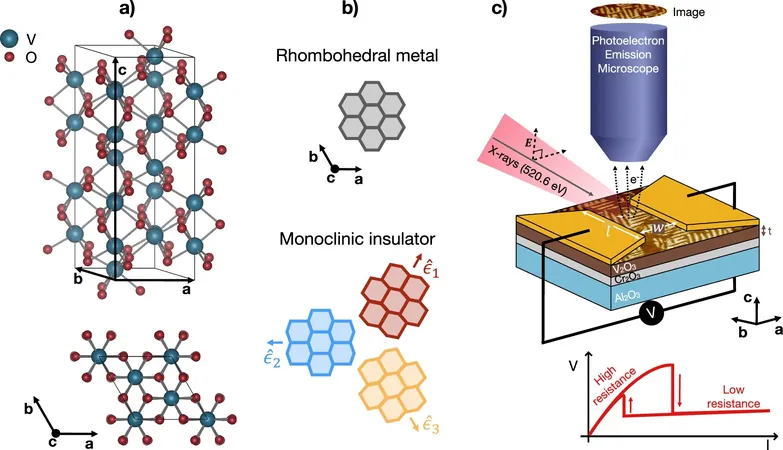
Groundbreaking Discovery: Topological Defects Enable Mott Materials to Switch from Insulating to Conductive States
2024-11-15
Author: Rajesh
In an exciting revelation from the Università Cattolica's Brescia campus, researchers have unveiled the surprising role that topological defects play in enabling Mott materials—peculiar insulators that can toggle between insulating and conductive phases. Their findings, published in the prestigious journal *Nature Communications*, shine a light on the unique behavior of these materials, particularly through their focused study on vanadium oxide (V₂O₃).
Mott Materials: A Shift in Understanding
Mott insulators stand out from conventional insulating materials not merely due to their structure, but because their insulating nature is largely dictated by strong electron interactions within the lattice. This study illustrates how these interactions can be manipulated through topological defects within the crystal structure. The nuances of this transformation process—referred to as resistive switching—drive not only theoretical pursuits but also potential technological advancements.
Advanced Techniques Unveil New Insights
Led by Professor Claudio Giannetti, the team collaborated with institutions like IMDEA Nanociencia, KU Leuven, SISSA, and Diamond Light Source to utilize advanced X-ray microscopy, which allowed them to observe the minute metallic channels forming at the nanoscale under electrical stress. Alessandra Milloch, the first author of the study, emphasized that while resistive switching was previously seen as a random event influenced by local fluctuations, this research clearly establishes that it can be systematically provoked by topological features.
Implications for Technology and Future Devices
The implications of this discovery are vast, particularly concerning applications in smart technologies. Mott materials like V₂O₃ have been gaining traction in sectors like power electronics and neuromorphic computing, where rapid changes in electrical and optical properties are crucial. Current technologies such as smart windows, advanced memory devices, and optical filters stand to benefit immensely from improved efficiencies and capabilities rooted in this research.
The research team emphasizes that the ability to switch states is not haphazard. Mariela Menghini, a research coordinator, noted that the insulating state of V₂O₃ is characterized by a distinct spatial infrastructure with nanometric domains whose transitions occur at clearly defined points. This knowledge opens new avenues for engineering specific properties in materials, paving the way for innovative applications like resistive random access memory (ReRAM), which promises faster speeds and reduced energy consumption compared to conventional memories.
The Road Ahead: Controlling the Switching Mechanism
Professor Giannetti elaborated on the potential for future experiments that could manipulate these topological defects deliberately, allowing for unprecedented control over the resistive switching phenomenon. With exciting prospects on the horizon, experts can now aim to integrate these findings into real-world technologies that require rapid data processing and energy efficiency.
This groundbreaking research not only redefines our understanding of Mott materials but also sets the stage for a new generation of devices that could revolutionize electronics, helping us stride confidently into a future where efficiency and speed are paramount. As we witness the merging of materials science and technology, the promise of a more intelligent and resource-efficient world is within our grasp. Stay tuned for more updates in this fast-evolving field!

 Brasil (PT)
Brasil (PT)
 Canada (EN)
Canada (EN)
 Chile (ES)
Chile (ES)
 España (ES)
España (ES)
 France (FR)
France (FR)
 Hong Kong (EN)
Hong Kong (EN)
 Italia (IT)
Italia (IT)
 日本 (JA)
日本 (JA)
 Magyarország (HU)
Magyarország (HU)
 Norge (NO)
Norge (NO)
 Polska (PL)
Polska (PL)
 Schweiz (DE)
Schweiz (DE)
 Singapore (EN)
Singapore (EN)
 Sverige (SV)
Sverige (SV)
 Suomi (FI)
Suomi (FI)
 Türkiye (TR)
Türkiye (TR)